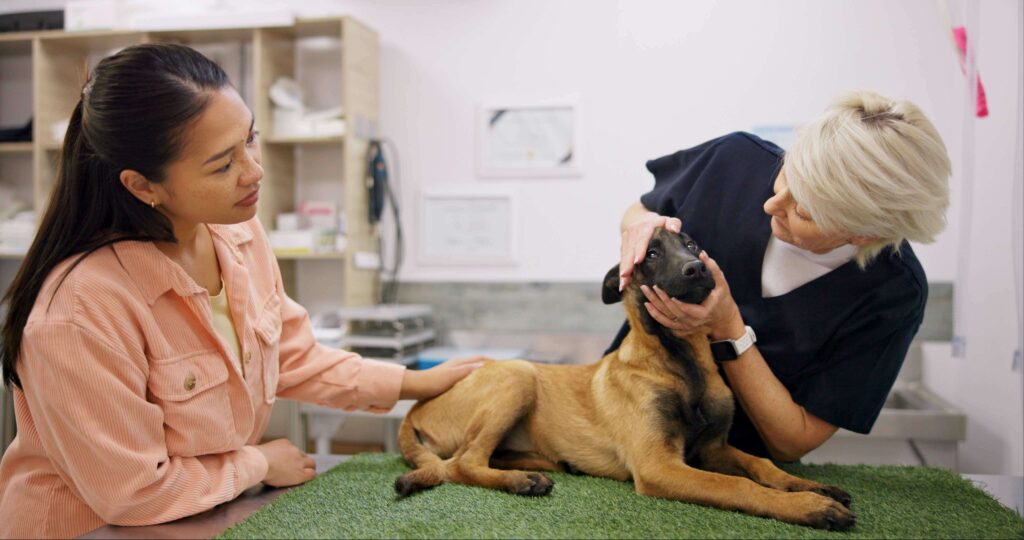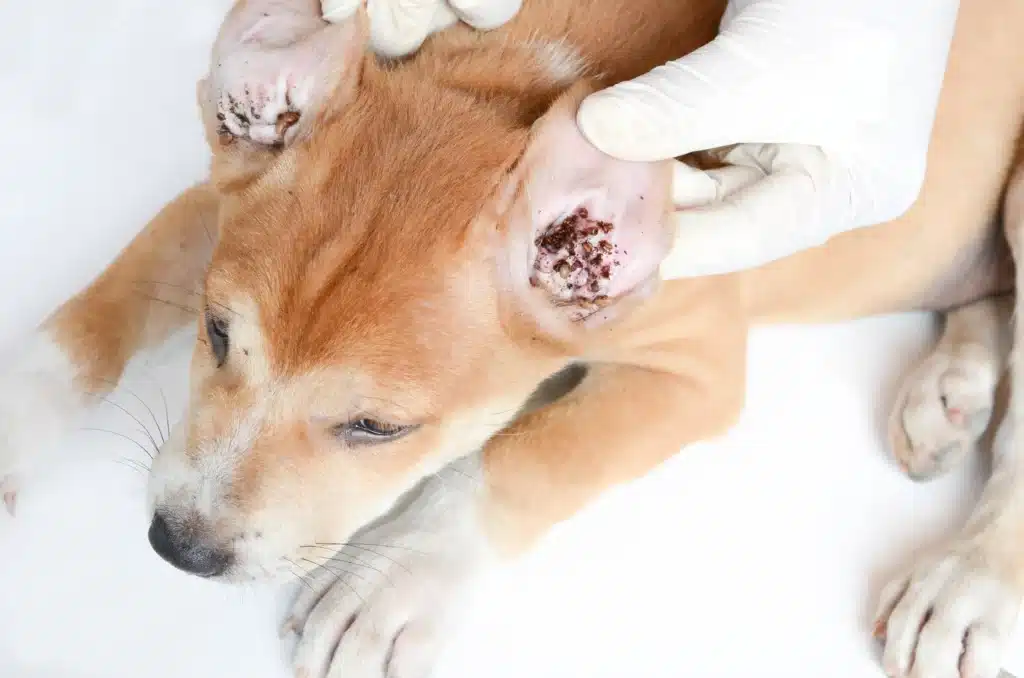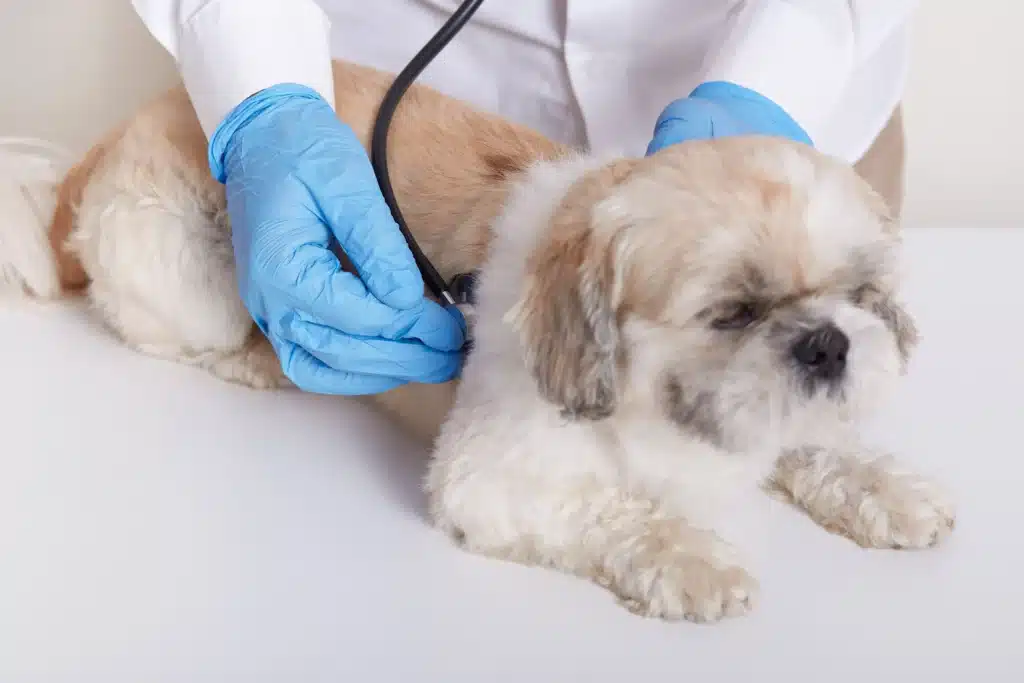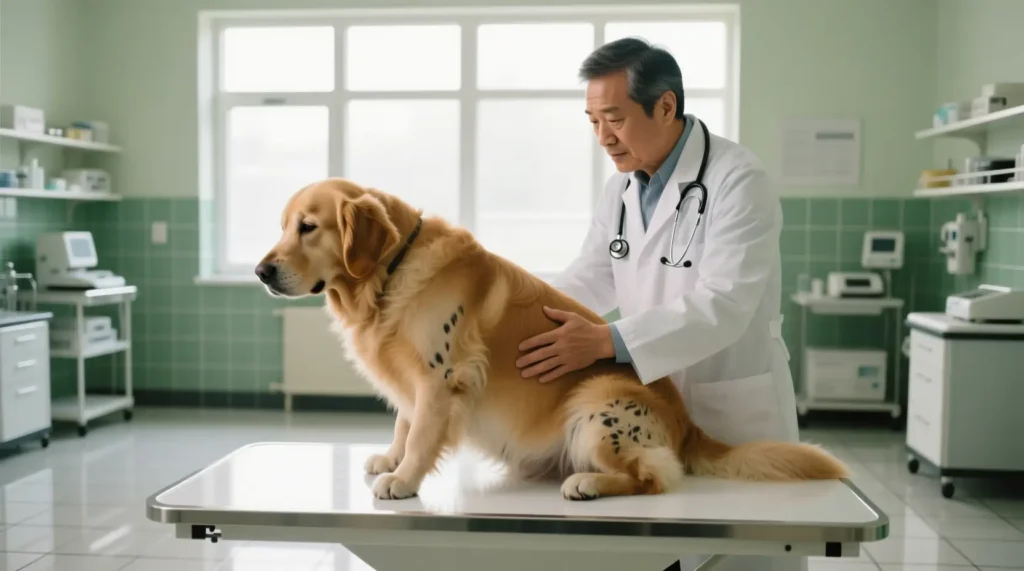Salmonella is a genus of Gram-negative, facultative anaerobic bacteria in the family Enterobacteriaceae. They are well-documented pathogens of many species, including humans, and are often associated with gastrointestinal illness, such as salmonellosis. In dogs, clinical Salmonella disease is infrequent; however, the organism is important for dogs as they can act as asymptomatic carriers of Salmonella, shedding in the faeces and possibly contaminating their environment or even transmitting to humans (zoonosis).
When a dog has an infection, Salmonella usually colonises the intestinal tract and can sometimes even result in enteritis (inflammation of the intestines) and diarrhoea. In severe cases, Salmonella can attack the intestinal barrier and develop systemic disease (septicemia). Many infected dogs can remain subclinical carriers of the infection by intermittently or continuously shedding Salmonella in their faeces while showing no signs of the infection.
In light of several factors, it is necessary to consider Salmonella risk in dogs.
- While most infections are subclinical or mild, severe infection can lead to dehydration, shock, and multiple organ dysfunction.
- Any dog shedding Salmonella can be considered a potential zoonosis risk, especially to vulnerable individuals, such as immunocompromised individuals and children.
- As shedding can be intermittent and infection can be subclinical, identifying an active case based on history and examination can be difficult, especially in terms of whether or not the dog is contaminated after time if it later tests positive, and in the case of continual testing by faecal culture is used as a screening tool.
- There are higher odds of Salmonella exposure and shedding risk in dogs that are fed raw and minimally processed meat-based diets.
2. Sources and Transmission
1.2.1 Major Transmission Routes
The faecal oral route, where dogs ingest Salmonella by eating contaminated faeces, food, or water, or by licking contaminated surfaces in the environment, is the commonest route of Salmonella infection for dogs. Foods that may be contaminated include:
• Foodborne: raw or undercooked meats, contaminated pet foods, or cross-contamination during food preparation.
• Water: Drinking from contaminated puddles or bowls, or from untreated water sources.
• Environment/fomites: Contaminated bedding, soil, co-mingling in kennels, or other surfaces that are contaminated with faecal matter.
• Animal-to-animal: Contact with an infected animal or with the animal’s excretions.
• Carrier animals: Dogs can also be carriers of Salmonella and may shed Salmonella intermittently even in the absence of signs of disease.
1.2.2 Infectious Dose & Virulence
The risk of illness from the illness process depends on:
• How many bacteria were ingested (the infectious dose).
• The virulence or serotype of Salmonella.
• The immune status of the dog (puppies, immunocompromised, and aged are at greater risk).
Low-level exposures may produce no signs of disease but can cause colonisation, intermittent shedding and/or diarrhoea.
1.2.3 Shedding and Carrier State
One of the most difficult aspects to control is the potential for dogs to shed Salmonella intermittently:
- In the acute phase, shedding may be continuous (especially during the first week).
- Then it may become sporadic over the next weeks to months.
- Some dogs become long-term carriers (weeks to months) with no obvious clinical signs. In one of the experimental studies, Salmonella was shed for up to 7 days after a single exposure from feeding infected raw food to dogs. None of the control dogs shed.
3. Typical Clinical Presentation
When Salmonella causes disease in dogs, gastrointestinal signs are most common:
- Diarrhoea (which may be watery or bloody)
- Vomiting
- Abdominal pain/cramping
- Loss of appetite (anorexia)
- Lethargy/weakness
- Fever
- Dehydration
- Weight loss (if illness is prolonged)

3.1 Systemic Signs
In more severe or systemic infections, signs may progress to:
- Elevated heart rate (tachycardia)
- Shock
- Pneumonia (if lungs become involved)
- Meningitis or neurological signs (rare)
- Reproductive tract infection or abortion in pregnant dogs
Many infected dogs remain subclinical while shedding, complicating recognition of the disease.
3.2 Risk Factors for Severe Disease
Dogs that are at a higher risk of developing severe disease include:
- Puppies and young dogs have immature immune systems.
- Immunocompromised dogs (from disease or medications)
- Dogs with GI disease or GI injury – Dogs under physical or psychological stress (e.g., hospitalised, diet changes)
- Dogs that have had exposure to a large dose of bacteria or virulent Salmonella
3.3 Pathophysiology
Once ingested, Salmonella can attach to intestinal epithelial cells to invade, provoke inflammation, and induce either secretory diarrhoea or damage to the intestinal mucosa. In extreme cases, bacteria may cross the gut barrier and enter the blood, resulting in a systemic infection, where they could localise to an organ (e.g., liver, spleen, lymph nodes) and subsequently persist in the phagocytic cells in the organ and promote chronic carriage and intermittent shedding of bacteria.
3.4 Prognosis
- In simple cases of gastrointestinal disease, prognosis is generally good with supportive care.
- If there is septicemic or systemic disease, the prognosis is more guarded, depending on which organs are affected.
- Subclinical carriers usually do not require treatment but can still pose a risk for environmental contamination.
3.5 Dietary Risk Factors (Especially Raw Food)
Diet represents one of the most changeable risk factors for dogs’ exposure to Salmonella. Numerous studies have reported heightened exposure and shedding risk associated with raw or under-processed meats in dogs.

3.5.1 Raw Diets / Raw Meat–Based Diets (RMBDs)
Raw diets (commercial or homemade) go untreated without heat or sterilisation, so pathogens such as Salmonella, E. coli or Campylobacter may survive
In the exposure trial with commercial raw diets, 16 dogs received raw diets contaminated with Salmonella, and at least 7 dogs tested positive for Salmonella (1-7 days later). No control dogs that were fed raw diets that did not contain Salmonella shed Salmonella. Clinical signs were not recorded in either group. Of the 7 dogs that tested positive, 5 dogs had the same serotypes as the raw diet, and for 2 of these dogs, they had matching antimicrobial resistance patterns (i.e. contamination → shedding) (raw diet exposure). ].
In another study, raw chicken BARF diets were tested; Salmonella was isolated in 80% of diet samples, and 30% of dogs that were fed these diets shed Salmonella in their faeces
3.5.2 Other Dietary / Feeding Practices
- Offering partially-cooked meats such as rare poultry increases risk.
- Untreated animal-origin treats, such as dried pig ears or raw bones, have also been associated with Salmonella contamination.
- Feeding raw organ meat or unconsumed portions of carcasses increases exposure.
- Allowing raw food to sit at room temperature or failure to provide appropriate refrigeration allows for potential bacterial growth.
- Offering access to raw meat or carcasses discarded from the garbage may lead to ingestion of pet food that is contaminated.
4. Supporting Population Evidence
- Among 415 dogs in Harar, Ethiopia, Salmonella was found in 6.3% (26/415) of dogs, with significantly higher prevalence in diarrheic (15.2%) than non-diarrheic dogs (5.5%).
- Furthermore, in the same study, female dogs were 2.5-fold more likely to shed than male dogs, and dogs fed an uncooked diet (offal) had 2-fold (OR = 2.0) more often than dogs fed a cooked diet.
Antimicrobial Resistance Patterns in Salmonella Isolates (Harar Study)
| Antimicrobial Agent | % Resistance |
| Ampicillin | 41.7% |
| Tetracycline | 21.2% |
| Amoxicillin‑clavulanate | 12.5% |
| Trimethoprim-sulfamethoxazole | 4.2% |
In total, 58.3% of isolates were resistant to at least one antimicrobial (Usmael et al. 2022).
Risk Factors Associated with Salmonella Shedding (Harar Study)
| Risk Factor | Odds / Relative Risk | Interpretation |
| Female sex | ~2.5× higher than males | Females are more likely to shed (p < 0.05) |
| Body condition (thin) | OR = 2.8 | Thin dogs had an elevated shedding risk |
| Body condition (overweight) | OR = 1.5 | Slightly elevated risk |
| Feeding uncooked (offal) diets | ~2.0× | Dogs fed uncooked diets had double the odds |
These patterns underline the interplay of diet, physiology, and management in Salmonella
5. Prevention & Treatment Strategies
A comprehensive prevention plan is necessary:
1. Dietary Safety & Waste Handling
- If a meat does not have a process to kill all pathogens. Avoid feeding raw or undercooked meat to pets.
- Make sure all meats are cooked thoroughly before feeding.
- Use designated utensils and work surfaces for raw or pet food.
- Ensure to wash hands thoroughly after handling raw meat or animal feces
- Clean and disinfect pet food bowls and feeding areas regularly.
- Source pet foods/ingredients from reputable sources.
- Limit or avoid high-risk treats, including raw bone and pig ears.
2. Environmental Hygiene
- Keep kennels, bedding and runs clean.
- Remove animal faeces as soon as possible and disinfect all surfaces.
- Do not allow dogs in water or areas with untreated water.
- Isolate dogs from others when they have diarrhoea until cleared.
3. Testing/Monitoring
- Be prepared for intermittent shedding and consider repeated faecal culture or PCR testing.
- During an outbreak or infectious period, test all dogs within a multi-dog situation or home.
- During the raw feeding consideration, evaluate the dogs periodically.
4. Biosecurity
- Quarantine any new dogs before introducing them to healthy dogs.
- Discourage rodents, insects and wildlife from getting into pet feeding areas.
- Educate pet owners about the potential for zoonotic disease and hygiene.
5. Risk Mitigation with Raw Diets (if a raw diet is utilised)
- Use raw products that have had a process to reduce pathogens, including irradiation or high pressure.
- Follow proper biosecurity measures during the handling and feeding process.
- Even with mitigation (as discussed previously), there will always be a risk associated.
6. Diagnosis
Diagnosis combines clinical and laboratory approaches:
- Obtain a detailed history (diet, onset, exposures).
- Perform a physical examination assessing hydration, vital signs, etc.
- Submit fresh faecal samples for culture or PCR (preferably over a few days).
- Bloodwork and cultures if systemic disease is suspected. • Use imaging or parasite testing to rule out other causes.
7. Treatment & Supportive Care
Antibiotics should be used carefully:
- Fluids and electrolytes: IV or subcutaneous, in order to replace losses.
- Nutrition: bland, digestible diets once vomiting stops.
- Antiemetics: used to control nausea and vomiting.
- Probiotics/gut support: restore balance in the microbiome.
- Monitoring: of vital signs, renal function, electrolytes etc.
- Isolation: to reduce spread to other animals or humans. Antimicrobials should only be used in the following settings:
- Systemic infections (septicemia)
- Immunocompromised dogs
Cases not improving with supportive care. Antimicrobial selection should be guided by sensitivity testing to reduce the potential for the development of resistance. Following resolution, Salmonella may be intermittently shed by the dog, recommending repeat fecal testing. Always watch for relapses, especially in times of stress or immune suppression.
6. Prognosis
- Uncomplicated GI cases: tend to do well with treatment,
- Systemic/septic cases: variable prognoses dependent on the organ involved and the degree of severity,
- Carriers: dogs may never fully clear Salmonella, but resolve systemically and are generally clinically well.
Conclusion & Key Takeaways
Salmonella infections in dogs represent a complicated scenario. Although ailments attributable to Salmonella in dogs are uncommon, dogs may serve as carriers and present a zoonotic risk. The following are the main conclusions and recommendations:
- Dogs may carry Salmonella and shed the organism in the absence of overt clinical signs.
- Raw or undercooked diets have a high likelihood of leading to Salmonella exposure and shedding.
- Results from published studies have shown prevalence rates between approximately 1% and 10% that depend on the geographic area, clinical conditions, and feeding practices.
- Microbial resistance is troubling where many Salmonella isolates are resistant to appropriate antibiotics, including, for example, ampicillin.
- Prevention is always best, including being knowledgeable about diet safety, hygiene, environmental issues, and surveillance.
- Treatment mostly involves supportive care, where antibiotics are reserved only for systemic disease.
- Because carriage and intermittent shedding can occur, repeated testing will be necessary if a dog is to be declared negative following a positive culture result.
References
- Groat, E. F., Williams, N. J., Pinchbeck, G., Warner, B., Simpson, A., & Schmidt, V. M. (2022). UK dogs eating raw meat diets have higher risk of Salmonella and antimicrobial‐resistant Escherichia coli faecal carriage. Journal of Small Animal Practice, 63(6), 435-441.
- Joffe, D. J., & Schlesinger, D. P. (2002). Preliminary assessment of the risk of Salmonella infection in dogs fed raw chicken diets. The Canadian Veterinary Journal, 43(6), 441.
- Usmael, B., Abraha, B., Alemu, S., Mummed, B., Hiko, A., & Abdurehman, A. (2022). Isolation, antimicrobial susceptibility patterns, and risk factors assessment of non-typhoidal Salmonella from apparently healthy and diarrheic dogs. BMC Veterinary Research, 18(1), 37.
- Zhao, M., Wang, X., He, J., Zhou, K., Xie, M., & Ding, H. (2024). Serovar and sequence type distribution and phenotypic and genotypic antimicrobial resistance of Salmonella originating from pet animals in Chongqing, China. Microbiology Spectrum, 12(7), e03542-23.


